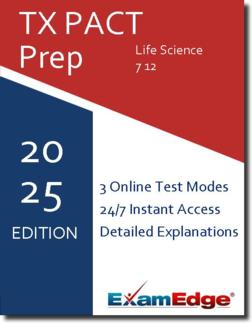TX PACT Life Science 7–12 (738) Practice Tests & Test Prep by Exam Edge - Topics
Based on 40 Reviews
- Real Exam Simulation: Timed questions and matching content build comfort for your TX PACT Life Science 7-12 test day.
- Instant, 24/7 Access: Web-based TX PACT Life Science Grades 7-12 practice exams with no software needed.
- Clear Explanations: Step-by-step answers and explanations for your TX PACT exam to strengthen understanding.
- Boosted Confidence: Reduces anxiety and improves test-taking skills to ace your TX PACT Life Science Grades 7-12 (738).

Understanding the exact breakdown of the TX PACT Life Science Grades 7-12 test will help you know what to expect and how to most effectively prepare. The TX PACT Life Science Grades 7-12 has 125 multiple-choice questions The exam will be broken down into the sections below:
| TX PACT Life Science Grades 7-12 Exam Blueprint | ||
|---|---|---|
| Domain Name | % | Number of Questions |
| Nature of Science | 20% | 25 |
| Biochemistry and Cell Biology | 13% | 16 |
| Genetics and Evolution | 27% | 34 |
| Biological Unity and Diversity | 20% | 25 |
| Ecology and Environment | 20% | 25 |


